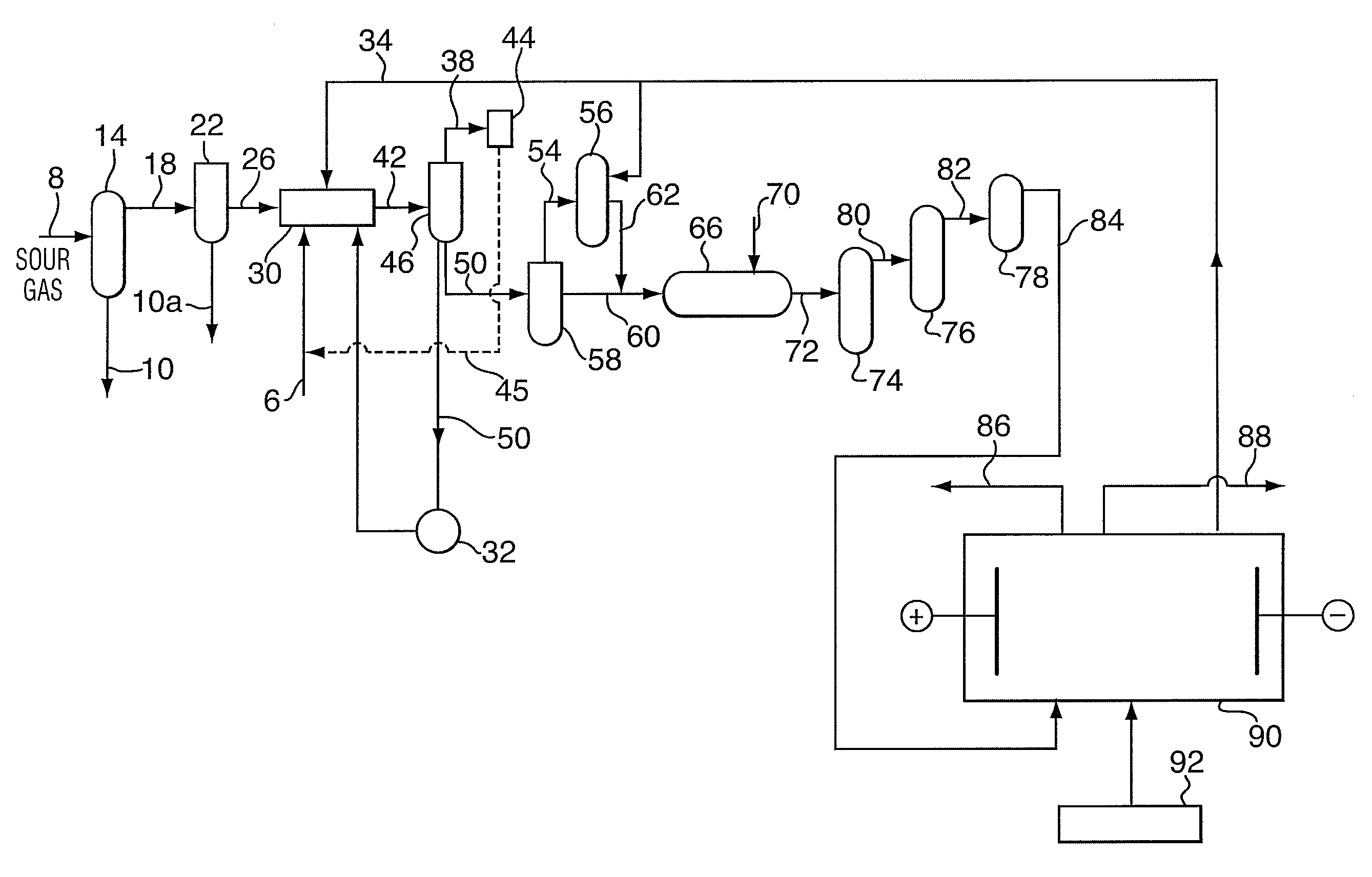Method for sour gas treatment
a technology of sour gas and treatment method, which is applied in the direction of electrolysis components, fluid pressure measurement using electrokinetic cells, semi-permeable membranes, etc., can solve the problem of high caustic consumption
- Summary
- Abstract
- Description
- Claims
- Application Information
AI Technical Summary
Benefits of technology
Problems solved by technology
Method used
Image
Examples
example 1
Operating Systems
[0043]Sour gas from an operating sour gas well was scrubbed. The scrubbing process used a static mixer as a scrubber in contrast to a trayed vessel traditionally used for bulk H2S removal with sodium hydroxide. An inlet caustic stream was sprayed into the sour gas, with minimal retention time allowed. Tests were conducted to determine if a H2S reaction occurs with minimal CO2 uptake, which may be due to a higher rate of mass transfer of H2S into the aqueous phase.
[0044]The major process variable values were recorded for each set of test conditions. The acid gas composition of the treated gas was recorded through sampling and on-site analysis. The gas flow rate was manipulated between 0.3 to 0.9 MMSCFD. The fresh caustic flow rate was manipulated between 0.5 to 1.2 USGPM. The total liquid flow rate to scrubber may be between 0.7 to 1.4 USGPM. Once the supplied NaOH to gas flow ratio goes beyond about 0.6 gmol OH / m3 gas, there may be little benefit in H2S removal. If ...
example 2
Oxidation System
[0055]Tests were designed to determine the basic process parameters for the partial oxidation to a sodium thiosulfate solution and the total oxidation to sodium sulfate solution. The objectives were to determine a practical, high performance and relatively cost effective process to oxidize the caustic scrubber solution to form either sodium sulfate (Na2SO4) or sodium thiosulfate (Na2S2O3) and to feed these salts to an electro dialysis process downstream.
Oxidation Data
[0056]Two oxidation tests were performed in a continuous stirred tank reactor (CSTR) with a Robin agitator at a pressure of 100 psig and a temperature of 130° C. The CSTR reactor is scalable to a commercial unit.
[0057]Test 1 was performed with a batch of synthetic liquor made from reagent grade sodium carbonate, bicarbonate and sulfide. The pH of the starting solution was 13. Oxidation of the synthetic solution produced the results is shown in Table 2 below. Batch oxidation to sulfate was, within the lim...
example 3
[0064]The overall objective of the research on filtration systems was to determine the effect of preliminary pre-treatment / filtration on the concentration of select chemical components in the scrubber solution. The most important components to remove were the metal hardness cations: calcium, magnesium, and iron.
[0065]A two stage filtering regime, first using a diatamateous earth (DE)+activated carbon (AC) filter bed and second with a 0.45 micron polishing filter (CH) under vacuum was used to filter all solutions after treatment. In addition, Amberlite IRC-747 treatment, either alone or with DE and AC was used.
[0066]The effect of the filtration system on the calcium, magnesium, iron, manganese, potassium, and sodium cation is included in Table 4. Amberlite IRC-747 was used. Amberlite IRC-747 is a polymer-based chelating resin widely used for metal removal and recovery in mining and chemicals, ground water remediation, waste water treatment, and brine softening. Amber...
PUM
| Property | Measurement | Unit |
|---|---|---|
| pressure | aaaaa | aaaaa |
| temperature | aaaaa | aaaaa |
| pressure | aaaaa | aaaaa |
Abstract
Description
Claims
Application Information
 Login to View More
Login to View More - R&D
- Intellectual Property
- Life Sciences
- Materials
- Tech Scout
- Unparalleled Data Quality
- Higher Quality Content
- 60% Fewer Hallucinations
Browse by: Latest US Patents, China's latest patents, Technical Efficacy Thesaurus, Application Domain, Technology Topic, Popular Technical Reports.
© 2025 PatSnap. All rights reserved.Legal|Privacy policy|Modern Slavery Act Transparency Statement|Sitemap|About US| Contact US: help@patsnap.com



